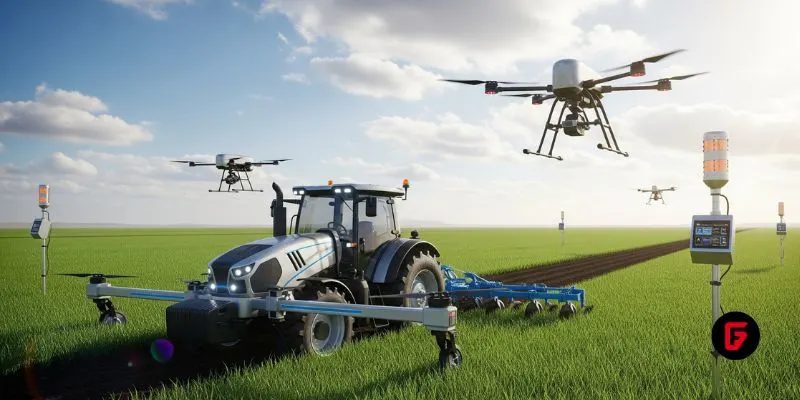Agricultural Robots: Farming’s High-Tech Revolution Unfolds
The world of agriculture is transforming as robotics and automation power a new era of productivity and sustainability. In fields from North America to Asia, these smart machines are fundamentally rethinking how our food is grown, harvested, and delivered. Whether you’re a technophile or a curious observer, you’ll want to keep your eye on the fast-moving agricultural robot market—it’s changing the future one field at a time.
What Is Driving the Rapid Growth of Agricultural Robots?
The agricultural robot market is riding a wave of momentum as demand accelerates for more productive, efficient, and sustainable farming solutions. Major drivers include:
Labor shortages: With populations shifting and declining interest in manual farm work, robots are stepping in where humans are harder to find.
Global food demand: The UN estimates the world’s population will surpass 8.6 billion by 2030, increasing pressure on farms to produce more with less waste.
Precision agriculture: Robotic systems offer pinpoint accuracy for tasks like weeding and fertilizing, dramatically reducing pesticide and resource wastage.
Environmental stewardship: Robots can target applications, helping conserve water, minimize chemicals, and improve sustainability.
| Statistic | Value / Detail |
|---|---|
| Global Market Size (2024) | USD 16.6 billion |
| Projected Market Size (2029) | USD 51.0 billion |
| Projected CAGR (2024–2029) | 25.2% |
| Estimated Market Size (2025) | USD 18.2 billion |
| Longer-term Market Projection (2030) | USD 48.06 billion |
| Longer-term Market Projection (2034) | USD 92.4 billion |
| CAGR (2023–2028) | 24.3% |
| U.S. Market Size (2024) | USD 3.1 billion |
| U.S. Market Forecast (2033) | USD 8.6 billion |
| U.S. Market CAGR (2025–2033) | 11.43% |
| Global Market Size (2024, alternate estimate) | USD 7.34 billion |
| Global Market Forecast (2032) | USD 26.35 billion |
| Projected CAGR (2025–2032) | 18.3% |
| Agricultural Robots and Drones Market Size (2025) | USD 7.43 billion |
| Agricultural Robots and Drones Market Forecast (2034) | USD 24.26 billion |
| Market Growth Drivers | Labor shortage, food demand rise, precision agriculture, sustainability mandates |
| Market Challenges | High upfront costs for small farms, technical complexity |
| Leading Regions | North America (dominant), Asia Pacific (fastest growing) |
| Emerging Trends | AI integration, autonomous tractors, crop-specific robots, electrification, modular designs |
How Do Agricultural Robots Transform Farm Efficiency and Productivity?
The benefits of robotic farming are already reshaping agriculture in profound ways:
24/7 operation: Robots don’t tire, allowing farms to extend planting and harvesting windows around the clock.
Real-time monitoring: High-tech sensors and AI-powered algorithms deliver instant feedback on crop health and soil conditions, letting farmers catch issues early.
Reduced labor costs: Automating repetitive, labor-intensive tasks means farms operate with fewer workers, minimizing payroll and streamlining operations.
Better yields: From precision planting to drone-based field surveying, every facet of robot-assisted farming aims to boost overall productivity and crop quality.
Sustainability: Robots enable site-specific management, using resources only where needed and supporting eco-friendly farming practices.
Emerging Trends and Innovations
Agricultural robots aren’t just limited to autonomous tractors. Watch for these standout innovations in 2025 and beyond:
Collaborative robots (“Cobots”): Designed to work alongside humans—especially for delicate tasks like fruit picking—reducing physical strain and increasing output.
Indoor & vertical farming robots: As urban food production grows, specialized robots manage crops in greenhouses and indoor farms, guaranteeing year-round quality.
Livestock management robots: Automated milking systems, feeding bots, and health monitors are revolutionizing animal agriculture.
Modular and customizable robotics: Farmers can tailor robots for specific needs, maximizing efficiency for unique crops and environments.
Why Is Adoption Challenging for Some Farmers?
Despite their advantages, agricultural robots aren’t without hurdles:
High upfront investment: Robotics installation can be costly, especially for small and family-run farms.
Skill requirements: Operating and maintaining these advanced systems often demands technical expertise that rural teams may lack.
Environmental challenges: Tough terrain and extreme weather can sometimes slow robot adoption or performance.
Awareness gap: Not all farmers are fully aware of the benefits or possibilities that robotics brings, though this is changing through outreach and government support.
In the face of global challenges, agricultural robots are rapidly becoming indispensable allies for modern farmers—driving efficiency, lowering costs, and making food production more resilient and sustainable than ever. Whether it’s drones scanning crops, autonomous vehicles planting seeds, or milking robots streamlining dairy farms, the marriage of technology and agriculture promises a bold, smart future.














